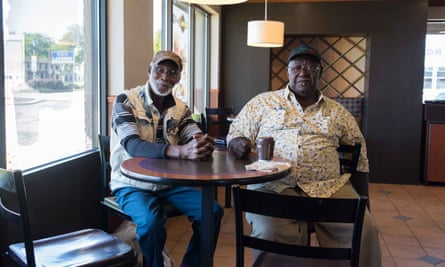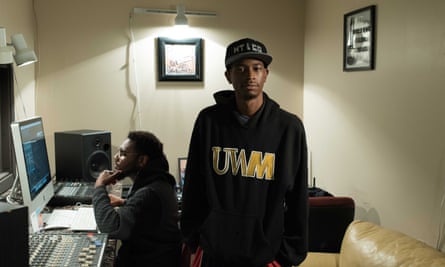It seemed too nice a place – houses too well kept, too many families out enjoying the late summer day – to have someone tell me my life was in imminent danger. But then again, I was a white outsider “acting suspicious” in Park West, an all-black Milwaukee neighborhood with a long history of being ostracized, humiliated and discriminated against by white people.
Weeks earlier, in nearby Sherman Park, buildings had been set on fire after 23-year-old Sylville Smith was killed by a police officer.
As I walked down the residential block, I was approached by two young men whose voices tangled into one. “You got some balls coming around here. What you want? You in danger. Big danger. People get shot here regularly. Hell, someone probably already done put a hit on you.”
The rest of the neighborhood took notice. Kids still dressed in Catholic school uniforms ran toward us and parents descended from porches, circling me in a scrum of questions and accusations.
“My child saw you earlier looking at the memorial of that murdered boy.”
“Why did you drive by so slowly, then look me straight in the eye, then come back five minutes later?”
“You got an accent, just like the new cops they are using have.”

I answered as many questions as I could: I wasn’t a cop, and I was here to write an article. That set off a second wave of frustration:
“We’re tired of being portrayed as nothing but thugs and killers.”
“Journalists just shove cameras in our faces and lie about us. Take shit out of context.”
“You just going to get the facts about that boy’s death wrong.”
I handed over my driver’s license and a young woman, 18-year-old Chanel Baney, found my author page online. She skimmed through some of my articles. “These headlines are legitimate.”
The two young men went away, and the rest of the neighborhood now surrounded me with openness and a desire to talk.
Chanel offered up her story first. “I ran inside when your car came, because I am scared of the police after what they did to me.” She told me that when she was 16 she had gone to a friend’s birthday party in a white neighborhood, only to be harassed by the police. “I was just leaving when they approached and accused me of crazy things, things I couldn’t have done. They confused me with someone else. When I argued I had done nothing wrong, I was thrown down, tased and charged with resisting arrest.”
The neighbors nodded. A mother named Yolanda Maddy explained how every child is taught to be wary of the police. If questioned or stopped, they’re told to do their best to maintain their cool. “Because if you don’t, you can die.”

When I left, an older woman, Sabrina Clark, apologized. “This neighborhood is good. We take care of each other. See, the police are not here to protect us. Neither are the politicians or the journalists. So we have to watch out ourselves.”
Milwaukee is one of the most racially segregated cities in America. It leads or is in the top of measures of racial inequality in terms of white v black unemployment and income, incarceration rates and educational achievement rates. It is also physically segregated to an extreme degree.
Such dismal numbers are the results of decades of willful ostracism. African American workers were locked out of most jobs and unions well into the 1940s. It was only when the second world war brought a surge in demand for labor that factories grudgingly acquiesced to hiring them. By the 1950s, the black population was growing rapidly, with most new arrivals coming from the rural south – and although they found more and better jobs, they didn’t find less racism.
Winston Williams, 84, came to Milwaukee in 1948, and like many retirees spends each morning in the neighborhood McDonald’s to gossip with friends. He was born in Turrell, Arkansas, and put to work picking cotton at eight years old. It was harsh work for little pay, but he started saving and by age 16 he had enough to leave.
“I remember that day perfectly. I could tell the time by the shadows the cotton cast, and when it got time for the morning bus north, I waved bye-bye to my family, and walked right out of the fields. I came here because there was talk of good jobs available. And there were. But you only could live in this one here neighborhood.” He gestured out the window, “If you went south of North Avenue, no way. You just were not allowed.”

John Barber, 74, could relate. He was born in Crawfordsville, Arkansas, and moved to Milwaukee in 1964. “Racism here was just as bad, but different. In the south they let you know it. Here they lied to you, and penned you in to this one neighborhood like a farm animal.”
The other assembled men all nodded. Each had their own variation of this story: a move away from sharecropping in the south to a Milwaukee that had plenty of jobs, but also plenty of racism.
Black people in Milwaukee were mostly limited to manual labor jobs, and only allowed to rent in a single neighborhood. As a result, home ownership was rare. It is those accumulated frustrations that led to demands that culminated in the 1960s fight for basic civil rights. After that came a backlash of violent white counter-protests against the black community.
The protests ended in legal victories which were impressive on paper – but by most residents’ accounts, things haven’t changed much. They live primarily in the same low-income neighborhoods, still primarily rent and don’t own their homes, and still feel harassed by the police.
Many residents point to only one big difference: there’s no jobs. The factories and big companies that offered up reliable union jobs without a need for college degrees – places like AO Smith, International Harvester, American Motors – all downsized or left in the 1980s and 1990s, leaving little work for those without a college education.
Fred Holloway, 63, came to Milwaukee in 1974 from Crowder, Mississippi, and now owns a building housing his barbershop, soon to become a daycare facility. He is by all measures a success, yet he is openly pessimistic.
“Is there racism here? Shiiiiiiiiiit. It so thick you can cut it with a knife. Things are hardly better than when I moved here. Then there were plenty of good jobs. I was a union welder. They ain’t passing out jobs like that any more. Kids got nothing now.”
If his is just nostalgia, then it is a uniform nostalgia: I heard from nobody who thought it was better now. Henry Trablers, 79, came from Mississippi in 1953 for factory work. “Then they needed us for jobs. Now they don’t. So there is nothing holding them back from holding these black kids back. So these kids got nothing to do. Nothing. So people call them lazy. You ain’t lazy if nobody will hire you. You just frustrated.”

That frustration, decades long, came to a head in August following the death of Sylville Smith, 23, shot by a police officer while fleeing from a traffic stop. His memorial – deflated Mylar balloons, Hennessy bottles and candles – has since the killing become an impromptu meeting spot for his friends and many others who stand guard to honor his memory until late in the evening.
When I approached to take a picture and interview them, I was met with a wave of yells. “No way you doing that. Nobody gave you any rights to come around here. Get out of here.”
When I explained I was attempting to give a fuller picture of the challenges faced by the neighborhood, I heard the same lines I had on the street filled with playing kids: “You going to just turn us into young thugs. They already have turned Sylville into a hoodlum, a gangster.”
Each time I came back and continued the dialogue, they put up a wall of silence or aggression. It was only when I mentioned the name of a local community organizer I had met that week that I was allowed to take pictures. It is easy to dismiss this aggression as misplaced, but antagonism toward outsiders is a necessary skill if outsiders have antagonized you your whole life.

A few blocks from the memorial, standing on an otherwise empty street corner, was Jemel Blackely, 30.
He owns and runs his own music studio inside the first floor of an otherwise empty building. He is excited to show me around, happy to explain his business, but also discouraged.
“Look. My dad is a cop, so I see both sides. But for us, for black kids, being outside is dangerous. One slip-up, one deviation, and we are incarcerated, or worse. We have no choice. We cannot do anything out of the norm presented to us. The only outlet we have is music and fashion. It is a kind of slavery of expectations.”
Venice Williams, a Lutheran minister and a local community activist, also lives in the neighborhood. She has helped turn an empty litter-filled block into a huge community garden where locals can grow their own food. “This community has been so hurt. The police, the politicians, outside businesses that come here haven’t honored our humanity. The garden for me is a space to provide healing.”
When I ask her about Syville’s memorial and those who stand guard, she’s quick to say she wishes it were different, she wishes they would find another way, but she is also quick to remind me: “Our young people are tired of being humiliated by police. Tired of being researched and over-analyzed by journalists and non-profits. This behavior, the clothing, the music, and sometimes the drugs and violence, this is the only toolbox these kids have. It is one filled with a need for pride and protection.”
My last night in Milwaukee, I wanted to have a drink. Unlike many other poor minority neighborhoods across the country, Milwaukee is filled with locally owned bars. I asked a few white acquaintances if they would want to join me. Everyone turned me down for various reasons, but some were a bit more blunt. “That is the neighborhood where people get shot.”
After spending much of the last seven years photographing minority neighborhoods, I am used to hearing them described as “the neighborhood where people get shot” by many who have no care to look further into the issue. One variation was used by Donald Trump in the debate on Monday, when he claimed “African Americans and Hispanics are living in hell. You walk down the street and you get shot.”
They are indeed the neighborhoods were people get shot, and sometimes it is by the police. Almost always it is the black residents themselves who get hurt. Yet these neighborhoods are far more than that: they are filled with residents who have long been demeaned, humiliated, and denied equal civil rights and opportunities. They are people who are just trying to get by, and who desire what anyone else wants: to work a decent job, and a chance for dignity.
A few blocks before the bar, I ran into Charles Jones, 61, who was closing up his barber shop. He has had a complex life, including time in jail for drugs, but he has been free of them for 15 years. We talked for an hour about his life, the neighborhood, racism. When I ask him about all the ongoing frustrations in his neighborhood, he looks grim.
“As my daddy always said, ‘What is going to happen if you only give nine bones to 10 dogs?’”
Read other articles in Chris Arnade’s series, Pride and Poverty in America

Comments (…)
Sign in or create your Guardian account to join the discussion